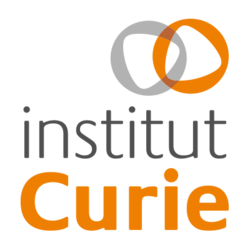Curie Institute (Paris)
Institut Curie is one of the leading medical, biological and biophysical research centres in the world. It is a private non-profit foundation operating a research center on biophysics, cell biology and oncology and a hospital specialized in treatment of cancer. It is located in Paris, France.
 | |
| Formation | 1920 |
|---|---|
| Type | Governmental organisation |
| Purpose | Fundamental research |
| Headquarters | 26 rue d'Ulm 75005 Paris |
Official language | French |
President | Thierry Philip |
| Website | institut-curie |
Research
The institute now operates several research units in cooperation with national research institutions CNRS and INSERM. There are several hundred research staff at the institute.[1] Institut Curie does not offer undergraduate degrees, but awards PhDs and employs many postdoctoral students alongside its permanent staff. Institut Curie is a constituent college (associate member) of University PSL[2].
Hospital
Institut Curie runs the Hôpital Claudius Régaud, a hospital specializing in cancer. The Institute also operates the proton therapy center at Orsay, one of the few such facilities in the world.
History
The Institut du Radium, a giant laboratory for Maria Skłodowska-Curie, was founded in 1909 by the University of Paris and Institut Pasteur. The Institut du Radium had two sections. The Curie laboratory, directed by Maria Skłodowska-Curie, was dedicated to physics and chemistry research. The Pasteur laboratory, directed by Dr. Claudius Regaud, was studying the biological and medical effects of radioactivity. After receiving a joint Nobel Prize with her husband Pierre in 1903, Maria Skłodowska-Curie won a second Nobel Prize for Chemistry in 1911. During World War One, Maria Skłodowska-Curie used it to teach nurses about radiology.
Maria Skłodowska-Curie and Claudius Regaud established the Foundation Curie in 1920, a public interest institution. The Foundation’s purpose was to fund the Institut du Radium’s activities and contribute to the development of its therapeutic component. A first hospital opened in 1922. At the clinic, Dr. Regaud and his team developed innovative treatments combining surgery and radiation therapy to treat cancer. The Curie Foundation became a model for cancer centers around the world. Curie laboratory continued to play an important role in physics and chemistry research. In 1934, Maria Skłodowska-Curie's daughter Irène and her son-in-law Frédéric Joliot-Curie discovered artificial radioactivity. In 1935, it was recognized with a Nobel Prize in Chemistry. The Institut du Radium and the Fondation Curie merged in 1970. It became Institut Curie. The Institut has three missions: research, teaching and treating cancer. The original building of Curies Laboratory from 1914 now houses the Musée Curie.
Nobel Laureates
Five Nobel prizes are attached to the Institute's researchers.
- Maria Skłodowska-Curie, Physics, 1903
- Maria Skłodowska-Curie. Chemistry, 1911
- Pierre Curie, Physics, 1903
- Irène and Frédéric Joliot-Curie, Chemistry, 1935
- Pierre-Gilles de Gennes, Physics, 1991
Famous alumni
- Maria Skłodowska-Curie, Physics
- Irène Joliot-Curie
- Frédéric Joliot-Curie
- Pierre-Gilles de Gennes
- Ștefania Mărăcineanu